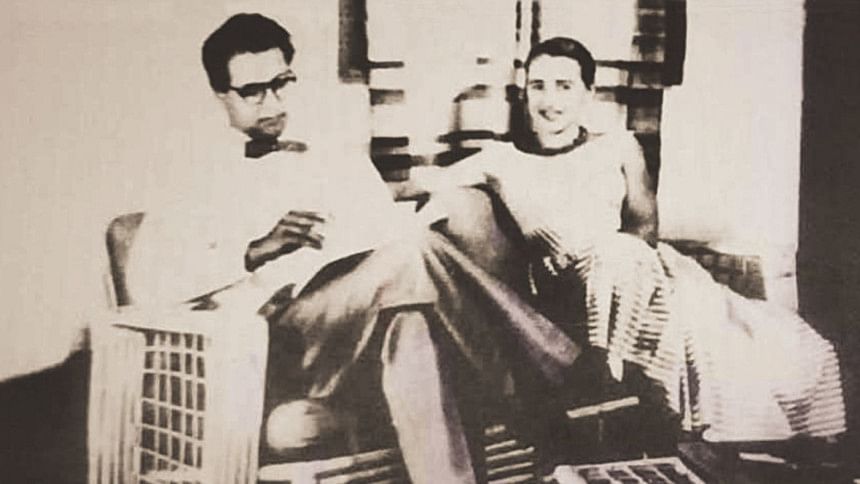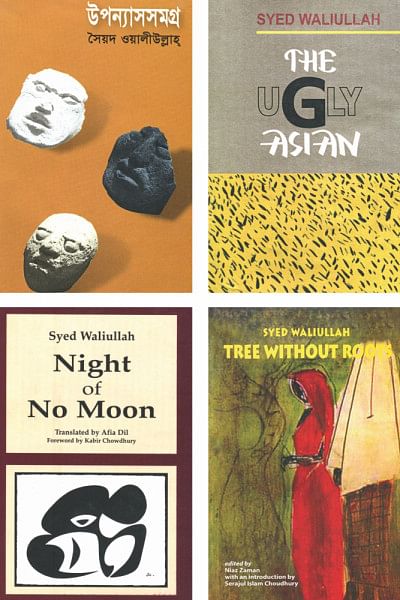Syed Waliullah Existentialism, Nostalgia, Nationalism

Syed Waliullah was born on 15 August 1922 at Sholashahar in Chittagong. His father, Syed Ahmadullah, was a government officer whose postings took him to different mofussil towns in Bengal: Mymensingh, Feni, Chittagong, Krishnanagar, Kurigram. Thus, the young Waliullah, who accompanied his father, was able to learn about rural life in Bengal. Apart from one unpublished piece of fiction in English, all Waliullah's writings are set in Bengal. His most famous novel, Lalsalu (1948), for example, was inspired by a shrine covered with red cloth that he would often pass when he lived with his father in Mymensingh.
Waliullah completed his BA from Anandamohan College in Mymensingh in 1943 and then moved to Calcutta, where he hoped to do his Masters in Economics. However, he was unable to complete his MA and joined the Statesman, where he worked till 1947. Proficient in English, he also briefly published an English journal, Contemporary.
In 1947, after the Partition, Syed Waliullah left Calcutta and came to Dhaka, joining Radio Pakistan. He was transferred to Karachi in 1950. In 1951 he left Radio Pakistan and served as press attaché at the Pakistan missions in New Delhi, Sydney, Jakarta and London. It was in Sydney that Waliullah met Anne Marie Thibaud, a French woman, whom he married in 1955. In 1960, he was posted as first secretary at the Pakistan embassy in Paris. In 1967, he joined the UNESCO in Paris.
During the Liberation War in 1971, Syed Waliullah worked with his friend Justice Abu Sayeed Chowdhury to enlist the support of a number of French intellectuals, including Pierre Emanuel and Andre Malraux, in mobilising world public opinion for Bangladesh. He passed away in Paris on 10 October that year, without having seen the liberation of the country.

Syed Waliullah was not a prolific writer. He has only two volumes of short stories, Nayanchara (1951) and Dui Teer O Anyanya Galpa (1965,) and three plays, Bahipeer (1960), Suranga (1964) and Tarangabhanga (1965). Apart from Lalsalu, he wrote two other novels in Bangla, Chander Amabasya (1964; Night of No Moon) and Kando Nadi Kando (1968; Cry, River, Cry), as well as a novel in English, The Ugly Asian, which he had written under a pseudonym and which was not published until 2013 by the Bangla Academy.
Despite his fairly brief output, Syed Waliullah is recognised as one of the foremost of contemporary Bengali writers. He received the Bangla Academy Award in 1961 before his two later novels were published, thus stressing the importance of Lalsalu. He also subsequently received the Adamjee Prize (1965) and the Ekushey Padak (1983).
For twenty years – from his posting in Karachi to his subsequent postings in different cities and his sojourn in Paris – Waliullah lived away from his Bangla-speaking milieu. Nevertheless, apart from one piece of fiction set in Paris, he continued to write about his homeland. However, as Professor Serajul Islam Choudhury has suggested in "Syed Waliullah and His Lonely Heroes," Syed Waliullah was often assailed by feelings that he was out of tune with his home country. He also perhaps felt a deep sense of nostalgia for the land that he had left behind.
Perhaps this is why he translated Lalsalu into English so that his wife could translate the novel into French. In 1961, Anne-Marie's French translation was published as L'Arbre Sans Racines. An English translation appeared in 1967, as Tree Without Roots, a translation of the French title. The names of four translators were given: Anne-Marie Thibaud, Qaiser Saeed, Jeffrey Gibian, and Malik Khayyam. However, after her husband's death, in "Waliullah, my husband as I saw him," Anne-Marie described how she had translated the book from Waliullah's own English translation.
Translated several years after Lalsalu had been written, Tree Without Roots has small but significant changes from its Bangla original. In the Bangla novel, Majeed is portrayed as a charlatan who exploits the religious beliefs of the common people to make a living for himself. At the end of Lalsalu, Majeed sternly tells the villagers bewailing their losses, "Do not be ungrateful. Have faith in God." Tree Without Roots agrees with the Bangla original in the essential storyline but has a longer description of the Bengal landscape and introduces a nobility in Majeed's character towards the end, missing in the Bangla version. In Tree Without Roots, Majeed leaves his two wives with his friend and strides off alone across the flooded land.
Waliullah's subsequent novels, Chander Amabasya and Kando Nadi Kando, written after he moved to Paris, reveal the influence of Jean Paul Sartre and Albert Camus. As Serajul Islam Choudhury notes, Waliullah introduced the existentialist strain into Bangla fiction. Chander Amabasya, for example, is about Aref Ali, a young teacher, who discovers the dead body of a young woman. He suspects an important villager of the murder but is caught up in a dilemma about revealing his suspicions. Finally, however, he musters up the courage to expose the murderer though he knows that by doing so he is signing his own death warrant.
Kando Nadi Kando juxtaposes the story of a dying river with the story of a young magistrate, Muhammad Mustafa. Pledged by his father to his cousin, Khodija, in their childhood, he cannot keep the pledge. When Khodija drowns herself in an algae-covered pond behind her house, he wonders whether she committed suicide when she learnt about his impending marriage. How far is he responsible if she did? Above all, how far are human beings responsible for the actions of others? This existentialist question haunts Muhammad Mustafa – as it does the narrator of the story.
Sometime in the late fifties/early sixties, Syed Waliullah was perhaps inspired by William J. Lederer and Eugene Burdick's The Ugly American to write a novel in English, and one very different from Lalsalu or his later existential novels. A political allegory, The Ugly Asian, takes place in an imaginary Asian country where there has just been a change of government. However, the new government is as corrupt and anti-people as the previous government and the novel ends with a revolution. The typescript of the novel has a pseudonym, Abu Sharya, which Waliullah also used for the unpublished "How to Cook Beans," his only piece of fiction not set in his motherland.
Set during the time of the Cold War, The Ugly Asian explores the relation of the US to an Asian country, which is attempting to throw off its colonial roots and which becomes the proxy scene of America's fight against Communism. Though different in language and theme from Waliullah's other novels, this novel too has a lonely hero in Professor Ahsan. Professor Ahsan fails, much as Majeed, Aref Ali, and Muhammad Mustafa fail. Unlike them, however, he is a political person and, through him, Waliullah seems to voice his opinion of world politics. Ahsan tells the American Johnson, who has been sent to see what is happening in the country, that even a small nation must be left to itself to decide what it wants. "Go and defend your own shores but not mine. I do not want you to defend anything of mine because I know that you are not defending me but yourself. I do not therefore accept you as my defender. If the other side comes to my country to defend itself, I will also ask him to leave my country."
If the US really wants to help Asians, it must learn what is important for Asians, what Asians want. In "An Asian Speaks," an afterword to The Ugly Asian, there is an imagined dialogue between an Asian peasant and an American, who speaks his language fluently. The American tries to convince the Asian that Communism is bad but fails to do so. "The American spoke the man's language. But the man did not understand what the American meant."
Niaz Zaman, who retired from the University of Dhaka, is Advisor, Department of English, Independent University, Bangladesh, and also publisher of Tree Without Roots, Night of No Moon, translated by Afia Dil, and Cry, River, Cry, translated by Osman Jamal.

The Cry of the River
Who was crying? What Moslehuddin's daughter, Sakina Khatun, said was eventually heard by many. But how was that possible? How could a river cry? It seemed to be folly even to ask if it was believable. A river can, like human beings, be young, then mature, grow old and die, but it lacks the power to cry. It cannot express its pain, it cannot articulate the feeblest protest when it arrives at death's door, it cannot even release a faint sigh looking at the two banks with which it had lived in close intimacy. It is really impossible for a river to cry. But where did that cry come from, from what suffering heart did the cry originate? Why indeed did a question of the kind chill the inside of one's heart? If that cry was the work of Satan, why did even God's name fail to silence it? One day a terrible idea occurred to someone. At first he could not pluck the courage to articulate it, but later, when he failed to bear it, he said in a faint voice, his eyes wide open, "Perhaps it is God who cries for his creatures." But why should anybody find peace in this sort of idea? If the One who created the universe – the moon and the sun and the stars, hills, mountains, seas and oceans – if He started crying, what would happen to man, where would he find strength?
Perhaps, finally, there was no alternative to believing in Sakina Khatun's strange story. The question to which they found no answer now appeared to be more frightening than the mysterious cry and, finding no escape from it, they accepted the impossible story: it was the river crying. The crying that they heard emerged from the suffering, grieving heart of the dying river. How could it be wrong to believe in such a story? Human beings believe in so many things, accept so many things as true, things for which there is no evidence. There are no limits to belief.
What Moslehuddin's daughter, Sakina Khatun, said was correct. The professional tout Maniruddin, sitting on a stool outside the tea-shop under the shadow of the aswatha tree, suddenly said, as if to himself, "Who would cry but the river? Isn't the river dying?" Though touting for a living, he was a pious soul, prayed five times a day, and fasted the required number of days. He said it naturally and it sounded natural. But, of course, who else would cry like that? There was no doubt that the river Bakal was dying. It was the dying river which was crying day and night. Why had they refused all this time to believe in something so obvious?
At last finding an answer to the question which had created a strange fear in their minds, the people of Kumurdanga breathed a sigh of relief. Suddenly it occurred to them that there was nothing frightening behind the mysterious cry they heard. The river which they didn't even care to look at now flooded their hearts with its own tears, and the relief they felt in their hearts now moistened at the river's pain. Suddenly it occurred to them that they had now come face to face with a sorrow of such dimension that human sorrow was trivial in comparison. In the face of the pain and suffering of a river which had flowed for ages, defying time, even the most poignant suffering of man was only a teardrop, an almost inaudible sigh.
Excerpt from Cry, River, Cry, translated by Osman Jamal

 For all latest news, follow The Daily Star's Google News channel.
For all latest news, follow The Daily Star's Google News channel. 



Comments